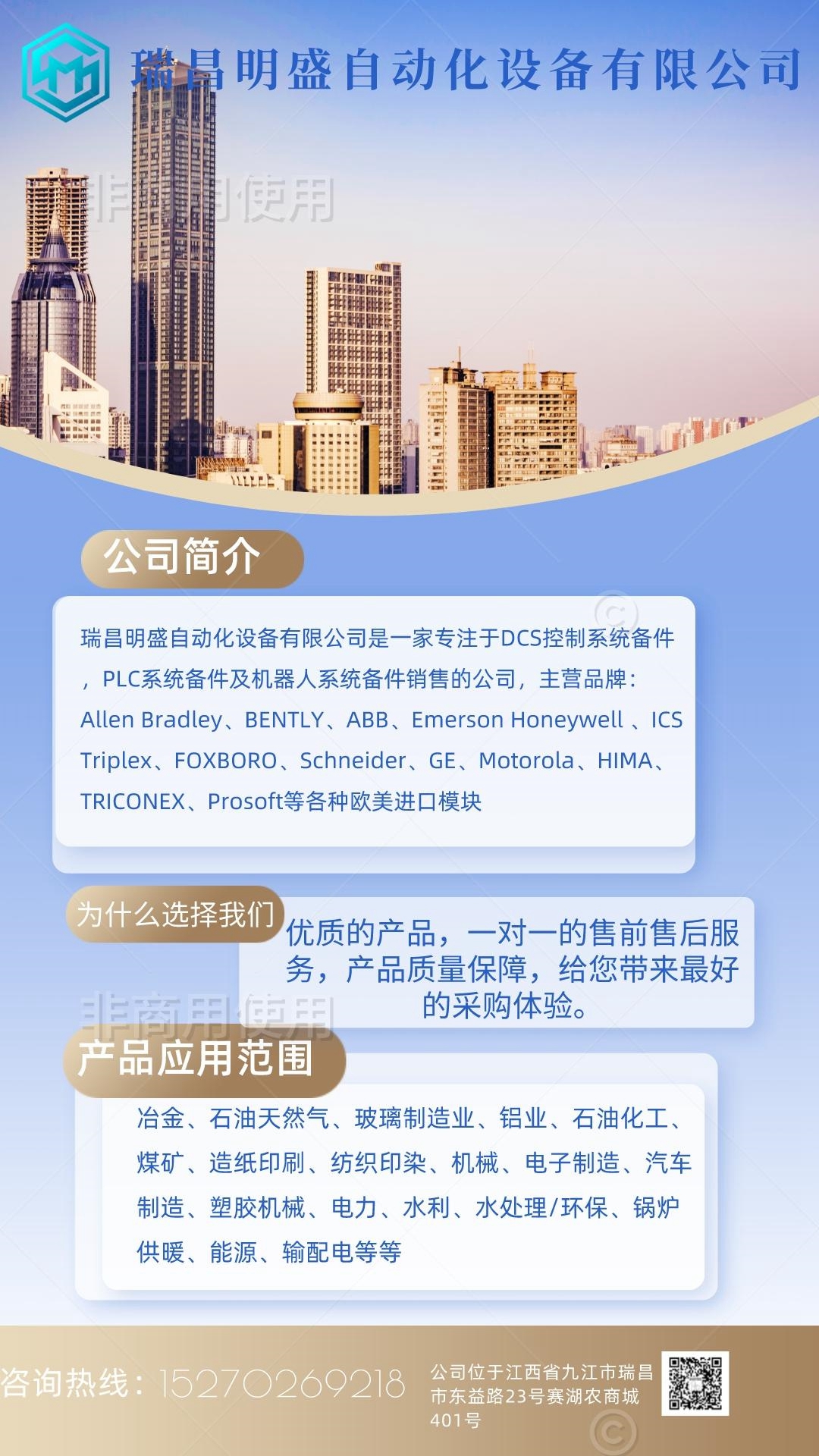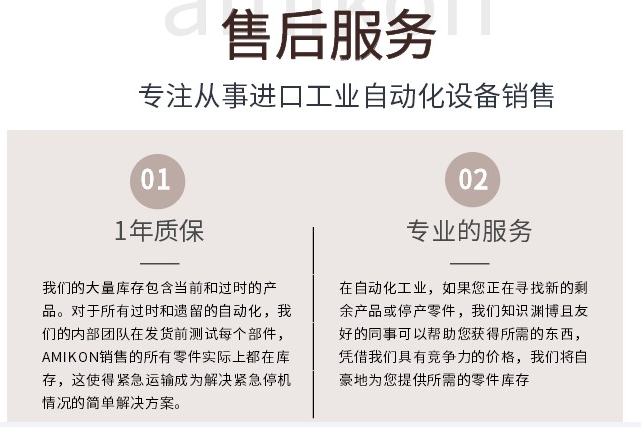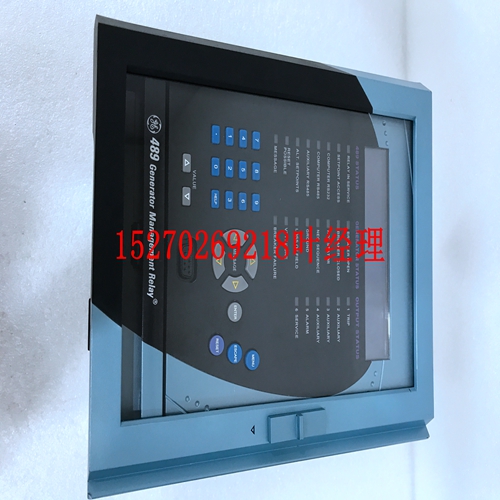IS200IVSHG1ABB控制器模块
作为活动或热备用模块。电源#1 6电源#2操作理论9 Tricon v9–v10系统I/O总线操作规划和安装指南每个I/O模块通过其相关的现场终端组件向现场传输信号或从现场传输信号。机箱中的两个位置作为一个逻辑插槽连接在一起。终端电缆系在背板顶部的面板连接器上。每个连接从终端模块延伸到活动和热备用I/O模块,这意味着活动模块和热备用模块从现场终端接线接收相同的信息。三重I/O总线以每秒375千比特的速度在I/O模块和主处理器之间传输数据。I/O总线沿背板底部承载。I/O总线的每个通道在一个主处理器和I/O模块上的相应通道之间运行。I/O总线使用一组三根I/O总线电缆在机箱之间延伸。通信总线操作主处理器和通信模块之间的通信总线以每秒2兆比特的速度运行。电源分配机箱的电源分布在两个独立的电源导轨上,并沿背板的中心向下。机箱中的每个模块都通过双电源调节器从两个电源轨获取电源。每个输入和输出板上有四套功率调节器:一套用于每个通道(A、B和C),一套用于状态指示器。10第1章Tricon v9–v10系统电源模块简介规划和安装指南每个Tricon控制器机箱包含两个以双冗余配置排列的电源模块。每个模块从背板获取电源,并为每个通道配备独立的电源调节器。每个模块都可以支持其所在机箱中所有模块的电源需求,并且每个模块都在机箱背板上为单独的电源导轨供电。电源模块具有内置诊断电路,用于检查电压是否超出范围和温度过高情况。通道上的短路会禁用电源调节器,而不会影响电源总线。图6电源模块子系统系统诊断和状态指示器体系结构Tricon控制器包含集成在线诊断。预计可能的故障模式,并通过专用电路进行检测。每个模块中的故障监测电路有助于满足这一要求。该电路包括但不限于I/O环回、死区计时器、功率损失传感器等。系统设计的这一方面使Tricon控制器能够根据每个模块和通道的健康状况重新配置自身并执行有限的自我修复。每个Tricon控制器模块都可以激活系统完整性警报。报警由每个电源模块上的常闭或常开(NC或NO)继电器触点组成。任何故障情况,包括系统电源损失或断电,都会激活警报,以召集电厂维护人员。每个模块的前面板都提供LED(发光二极管)指示灯,显示模块或其所连接的外部系统的状态。通过、故障和激活是常见的指示灯。其他指标针对每个模块。单个模块报警滤波器DC-DC转换器故障检测-+桥式整流器电源模块#1接地电压轨2电压轨1滤波器DC-DC变换器故障检测--+桥式整流电源模块#2 Vcc Vcc R E G R E G G R E R G R E E G G A B C NO NC C NO NC NC常开NC常闭C通用操作理论11 Tricon v9–v10规划和安装指南系统维护包括更换插件模块。点亮的故障指示灯表示模块检测到故障,必须更换。指示器的控制电路与三个通道中的每一个隔离,并且是冗余的。所有内部诊断和报警状态数据可用于远程日志记录和报告生成。
as the active or hot-spare module. Power Supply #1 6 Power Supply #2 Theory of Operation 9 Planning and Installation Guide for Tricon v9–v10 Systems I/O Bus Operation Each I/O module transfers signals to or from the field through its associated field termination assembly. Two positions in the chassis tie together as one logical slot. Termination cables are tied to panel connectors at the top of the backplane. Each connection extends from the termination module to both active and hot-spare I/O modules, which means both the active module and the hot-spare module receive the same information from the field termination wiring. The triplicated I/O bus transfers data between the I/O modules and the Main Processors at 375 kilobits per second. The I/O bus is carried along the bottom of the backplane. Each channel of the I/O bus runs between one Main Processor and the corresponding channels on the I/O module. The I/O bus extends between chassis using a set of three I/O bus cables. Communication Bus Operation The communication bus runs between the Main Processors and the communication modules at 2 megabits per second. Power Distribution Power for the chassis is distributed across two independent power rails and down the center of the backplane. Each module in the chassis draws power from both power rails through dual power regulators. There are four sets of power regulators on each input and output board: one set for each channel (A, B, and C) and one set for the status indicators. 10 Chapter 1 Introduction Planning and Installation Guide for Tricon v9–v10 Systems Power Modules Each Tricon controller chassis houses two Power Modules arranged in a dual-redundant configuration. Each module derives power from the backplane and has independent power regulators for each channel. Each can support the power requirements for all the modules in the chassis in which it resides, and each feeds a separate power rail on the chassis backplane. The Power Modules have built-in diagnostic circuitry which checks for out-of-range voltages and over-temperature conditions. A short on a channel disables the power regulator rather than affecting the power bus. Figure 6 Architecture of Power Module Subsystem System Diagnostics and Status Indicators The Tricon controller incorporates integral online diagnostics. Probable failure modes are anticipated and made detectable by specialized circuitry. Fault-monitoring circuitry in each module helps fulfill this requirement. The circuitry includes but is not limited to I/O loopback, deadman timers, loss-of-power sensors, and so on. This aspect of the system design enables the Tricon controller to reconfigure itself and perform limited self-repair according to the health of each module and channel. Each Tricon controller module can activate the system integrity alarm. The alarm consists of a normally closed or normally opened (NC or NO) relay contact on each Power Module. Any failure condition, including loss or brownout of system power, activates the alarm to summon plant maintenance personnel. The front panel of each module provides LED (light-emitting-diode) indicators that show the status of the module or the external systems to which it is connected. Pass, Fault, and Active are common indicators. Other indicators are specific to each module. Individual Module Alarm Filter DC-DC Converter Fault Detect - + Bridge Rectifier Power Module #1 Ground Voltage Rail 2 Voltage Rail 1 Filter DC-DC Converter Fault Detect - + Bridge Rectifier Power Module #2 Vcc Vcc Vcc R E G R E G R E G R E G R E G R E G A B C NO NC C NO NC C NO Normally Open NC Normally Closed C Common Theory of Operation 11 Planning and Installation Guide for Tricon v9–v10 Systems Maintenance consists of replacing plug-in modules. A lighted Fault indicator shows that the module has detected a fault and must be replaced. The control circuitry for the indicators is isolated from each of the three channels and is redundant. All internal diagnostic and alarm status data is available for remote logging and report generation.












